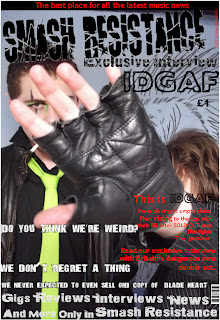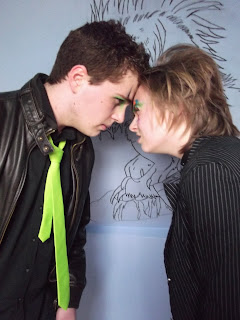For instance, when I created my first ever school college magazine as part of my pre-lim task the image was of poor quality and it was badly edited.
As you can see this version of the magazine was not brilliant so I went back and took 3 new pictures and created 3 better magazine covers.
The masthead of this cover has no colour to it and it is really hard to see, and the coverlines don't really show up on this and the quality is not very good. And when I went back and created the 3 other magazine covers I think the quality improved alot more.
The masthead of this cover has no colour to it and it is really hard to see, and the coverlines don't really show up on this and the quality is not very good. And when I went back and created the 3 other magazine covers I think the quality improved alot more.
This magazine front cover is not brilliant but with this masthead you can clearly see it, I manipulated the masthead so that it stood out more on the page. and the camera shot is a medium shot and the cover doesn't look like a magazine cover much apart from the cover lines and the puff at the top right of the page
This final cover doesn't look like a magazine cover much, the page looks too full of pictures and it's hard to distinguish which one is the main picture and which ones are just cover lines.
The masthead is small on the page and I should've included an exclusive on the page, or the website address.
In these 3 images it was much better quality than my original mock up.
So I think my skills have developed abit more over time, because I’ve been able to recognise where I’ve gone wrong in the past with my magazine covers and been able to correct them.
For all 3 of these images I made the cover girl give me a direct mode of address and the mise en scene of the area is that she looks fitting for our ‘winter’ issue of the school magazine.
So I think my skills have developed abit more over time, because I’ve been able to recognise where I’ve gone wrong in the past with my magazine covers and been able to correct them.
For all 3 of these images I made the cover girl give me a direct mode of address and the mise en scene of the area is that she looks fitting for our ‘winter’ issue of the school magazine.
I have learnt a lot more about constructing images aswell, I’ve learnt about the different types of camera angles used to make a cover look good and what type of angle to go for when making the artists or cover stars used to look in a particular way, whether you want them to look inferior or superior or if you want them to give a direct mode of address to the audience.
What I have learnt about image manipulation is to be very patient with it, because especially if you do not have a computer which can access a program like Photoshop it can be hard to change photographs around, but I mainly manipulated with the font and font styles, I often had to recolor it to make the white background go away, or make the shadow on the header a lot more bolder, so it would stand out on the page.
What I’ve learnt about designing layouts is, not to make the front cover look too cluttered if there is too much text upon the page then the audience will get bored of reading and move on. But if there is either a balance between image and text or we make the cover lines interesting then it attracts the reader’s attention.
I have learnt that with different types of magazines you of course get different target audiences, with the school/college magazine there was a different target audience of about 16-19 year olds, with little income and who would be interested in things abit more academic so I made my college magazine more focussed on education and the future- Whereas my music magazine had a wider target audience of 16-24 who would be interested in gigs and festivals and who would also have little income so the types of words I used and the things I tried to put across related differently to my different target audiences.
What I have learnt about image manipulation is to be very patient with it, because especially if you do not have a computer which can access a program like Photoshop it can be hard to change photographs around, but I mainly manipulated with the font and font styles, I often had to recolor it to make the white background go away, or make the shadow on the header a lot more bolder, so it would stand out on the page.
What I’ve learnt about designing layouts is, not to make the front cover look too cluttered if there is too much text upon the page then the audience will get bored of reading and move on. But if there is either a balance between image and text or we make the cover lines interesting then it attracts the reader’s attention.
I have learnt that with different types of magazines you of course get different target audiences, with the school/college magazine there was a different target audience of about 16-19 year olds, with little income and who would be interested in things abit more academic so I made my college magazine more focussed on education and the future- Whereas my music magazine had a wider target audience of 16-24 who would be interested in gigs and festivals and who would also have little income so the types of words I used and the things I tried to put across related differently to my different target audiences.







































